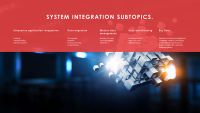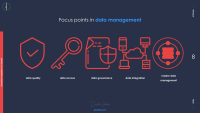Please find my perspective at what is Enterprise (System) Integration for the business solution. Why to invest in system integration? What is the business value from system integration?
Over the years, I designed and implemented many system integration solutions. More and more companies are digitalizing their business, expanding information portfolio by new and new systems day by day. It is an increasingly higher priority that there is a need for fast data exchange between these systems.

What is system integration about
There are no longer multiple layers of business logic that read and write to a single data layer. Instead, solutions are designed around a data pipeline that describes how data flows through a solution, where it is processed, where it is stored, and how it is consumed by the next component in the pipeline. From the data perspective system integration means:
data routing from multiple sources (database, information system, mobile/web app) into a single system/platform within one or many organizations;
reconciling of different types of data in a single format that is used for diverse data manipulation, transformation, and synchronization.
System integration is a crucial and sometimes even a necessary part of many IT solutions for business. It would, in the meantime, be complex to implement and to sustain such a solution. System integration is a term that covers a range of the following subtopics:
Enterprise application integration. Creating interoperability between systems;
Data migration. Moving data between locations, formats, or applications;
Master data management. An effort to create one single master reference;
Data warehousing. Central sources of data from many different sources;
Big Data. Big data architecture is designed to handle the ingestion, processing, and analysis of data that is too large or complex for traditional database systems.
An important aspect that helps improve the value of the enterprise business processes is the ability to flexibly and rapidly create and change those processes. To do this, different software applications that support these processes must be able to communicate with each other. However, not all software applications provide adequate interoperability by design. So, allowing all those different applications to interoperate can be both time-consuming and costly due to different transmission protocols and data exchange formats.
When might you consider system integration automation
two companies are merging;
the consolidation of internal applications is needed;
common application and data reuse;
implementation of consistent functionality;
distribution of responsibilities;
a dedicated source of truth to reduce duplication of data, rules, and processes;
auditing (end-to-end as well) and non-repudiation of business activities and operations;
improving the performance of LOB systems;
maintaining a consistent state of business data across multiple systems;
streamline data transformation and data loading scenarios;
two-phase commits;
data definition uniformity;
an abstraction of underlying systems;
high volume/low latency transactions.
Focus points in data management
data quality;
data access;
data governance;
data integration;
master data management;
Ask yourself before start
| Business analysis and requirements | Source systems and data |
|---|---|
| What is the goal of data integration? | What are the data extraction options? |
| What are the deliverables and objectives? | How is data quality? |
| What are the business rules? | What are the data volumes being processed? |
| Where will the data be sourced from? | What is the frequency of extraction? |
How does system integration engineer help you
definition of integration principles, patterns, and approaches to implementation:
– Enterprise Service Bus (ESB);
– Integration Platform as a Service;
– API management;
definition of data models (logical, canonical and physical), schemas and formats;
definition of technologies and approaches to data integration;
data transformation, data mapping;
an abstraction of service endpoints from their source applications;
definition of communication protocols, message exchange patterns, and routing mechanisms;
analyzing the available applications’ technical capabilities;
design of service interaction activities (service requestors, service providers);
design of message processing;
considerations regarding security, management of business processes, events, and rules.
My services
Look through the slides














